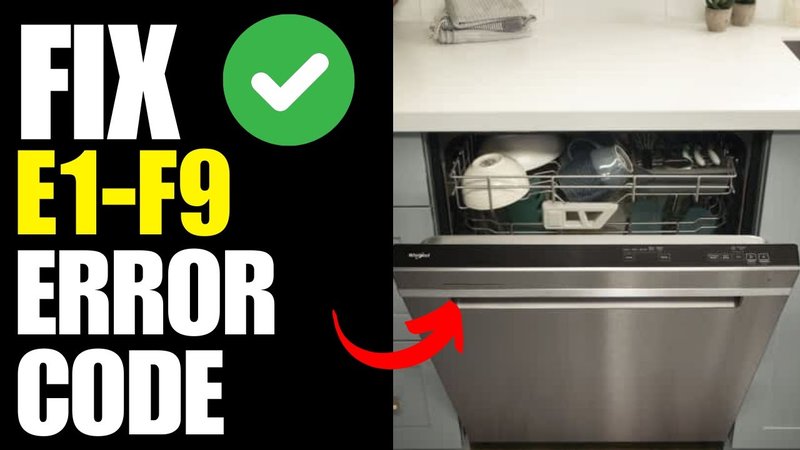
In simple terms, the E1 error code on your Whirlpool dishwasher indicates a problem with the water inlet system. Just like when a garden hose gets kinked, the water doesn’t flow properly, and your dishwasher struggles to get the job done. Thankfully, warranty coverage might just come to the rescue, saving you from unexpected repair bills. But warranties can be a bit like deciphering a foreign language, filled with nuances and exceptions. Let’s dive deeper into what this error means and whether your dishwasher’s warranty has got your back.
Understanding the E1 Error Code
You might be wondering, what exactly causes the E1 error code to appear? Think of your dishwasher’s water inlet valve as the gatekeeper of water flow. If something goes amiss there, like a clog or a malfunction, it’s similar to trying to drink soda through a blocked straw — it just doesn’t work right. The dishwasher detects this issue and throws the E1 error code to alert you.
The most common culprits for an E1 error include a faulty water inlet valve, insufficient water pressure from your home’s supply, or a kinked inlet hose. These are like the usual suspects your dishwasher points fingers at when it can’t get the water it needs. Not addressing these problems can lead to more than just dirty dishes — you could be looking at a whole host of operational issues down the line.
If you’re encountering this error frequently, the first step is to check the water supply to your dishwasher. Ensure there are no blockages or kinks in the hose, and that your water pressure is adequate. But if the error persists, it might be time to consider whether your warranty covers this type of repair.
What Does the Warranty Cover?
Now, here’s the deal: warranties can be a lifesaver, but they come with fine print. Most Whirlpool dishwasher warranties cover defects in materials and workmanship, which sounds like they’d cover just about anything that goes wrong. However, it’s not always that straightforward.
Generally, if the E1 error code is due to a manufacturing defect or a faulty part that shouldn’t wear out prematurely, the warranty should cover it. Think of it like getting a new pair of shoes with a sole that falls off the first time you wear them — you’d expect a replacement, right? However, if the issue stems from external problems like your home’s water pressure, or if the problem developed after the warranty expired, that’s typically not covered.
It’s crucial to read through your warranty documentation. Warranties can vary, even amongst different Whirlpool models. Some may offer extended coverage for particular parts, while others might only provide limited service periods. If in doubt, reaching out to Whirlpool customer service can clarify what’s covered and what’s not, potentially saving you from unwanted expenses.
Steps to Take When an Error Occurs
So, you’ve got an E1 error code blinking at you. What should you do next? First, don’t panic. It’s like getting a text message from your dishwasher saying it needs a little attention. Before calling in reinforcements, you might want to attempt some basic troubleshooting.
Start by checking that the water supply to the dishwasher is turned on and that the hose isn’t tangled or obstructed. If everything seems fine, resetting the dishwasher might clear the error. Unplug your dishwasher or switch off the circuit breaker for a few minutes, then turn it back on. This simple act can sometimes resolve minor electronic hiccups.
However, if the error code remains stubborn and reappears, that’s when you consider leveraging your warranty. Contact a certified technician to assess the situation if you’re still within the warranty period. They’ll determine if it’s a defect that your warranty covers.
Preventative Tips and Final Thoughts
No one wants to deal with unexpected appliance issues – it’s like a surprise bill in the mail. To avoid the E1 error in the future, regular maintenance can be your best friend. Routinely check hoses for kinks and ensure that your home’s water pressure aligns with your dishwasher’s requirements.
Additionally, running a dishwasher cleaner through a cycle now and then helps keep internal components free from mineral build-up. It’s like giving your dishwasher a spa day, helping it run smoother and last longer.
In conclusion, while the E1 error can be a nuisance, understanding its causes and how your warranty may protect you can save you time and trouble. Armed with the right information, you’re well on your way to resolving this issue and getting back to effortlessly sparkling dishes.